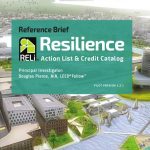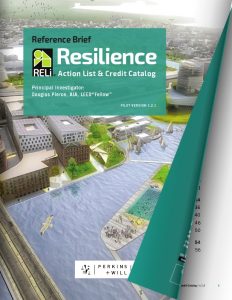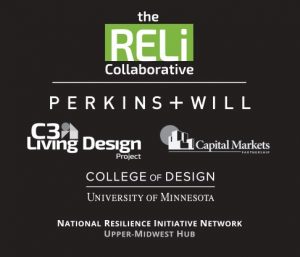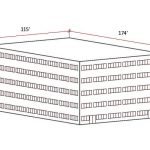
Sustaining a reasonable level of safety and quality in our day-to-day lives now requires that we collectively respond to weather extremes, economic disruptions, and resource depletions that are becoming commonplace globally, regionally, and locally. Resilience involves interactive social, economic, and environmental elements that respond to both acute short-term and systemic long-term topics related to the well-being of our society and planet.
The RELi Resilience Action List + Credit Catalog combines a comprehensive list of resilient design criteria with the latest in proven integrative process for developing next generation communities, neighborhoods, buildings and infrastructure. RELi is a project rating system similar to LEED®, but with added emphasis on resilience. The Credit Catalog includes new resilience-based actions (requisites + credits) pioneered for RELi in 2014.
RELi also aggregates action items from other sustainable guidelines that support resiliency. RELi Categories include: Panoramic Approach, Hazard Preparedness, Hazard Adaptation, Community Vitality, Productivity / Health + Diversity, Energy / Water + Food, Materials + Artifacts and Applied Creativity.
Design method is an important part of achieving high-performing resilient design outcomes. In response, RELi combines a comprehensive + expandable action list with an integrative process called the Living Design Approach. This universal method is embodied in the RELi Panoramic Approach category as a series of requisites + credits. The RELi Reference Brief, along with other resources are openly available for use by project teams of all types.
RELi Action List + Credit Catalog
Reference Brief Online Flipbook, Pilot Version 1.2.1
(Abbreviated from the 2014 RELi National Consensus Standard)

What is Resilient Design?
Resilient Design pursues Buildings + Communities that are shock resistant, healthy, adaptable and regenerative through a combination of diversity, foresight and the capacity for self-organization and learning. A Resilient Society can withstand shocks and rebuild itself when necessary. It requires humans to embrace their capacity to anticipate, plan and adapt for the future – RELi Action List + Credit Catalog Author Doug Pierce
The RELi Action List + Credit Catalog offers an actionable definition of resilience by providing metrics, measures and indicators for resilient buildings, neighborhoods and communities. An online version is available free of charge to project teams. The Use Agreement is included on page 9.
Resilience is one of five interwoven Living Design Metapatterns that include: Resilience, Restoration, Regeneration, Sustainability and Wellness. The following definition of resilience has guided our development and selection of metrics and measures for inclusion in the RELi Resilience Action List + Catalog:

The Reli Collaborative
More resources including a downloadable Excel RELi Tally Sheet for tracking project goals, social media feeds and other resources are available at the RELi Collaborative Homepage.
Partial List of Reports Citing RELi
Obama White House Office of Management + Budget (OMB), December 2016
RELi is referenced on page 24 as one of seven programs warranting further consideration by Federal risk and insurance programs.
White House OMB Report “Standards and Finance To Support Community Resilience”
International Risk Governance Council | Report chaired by Leah Flax, Rockefeller Foundation 100 Resilient Cities
RELi is one of only 5 resilience guides included in this informative white paper.
“Measuring Urban Resilience As You Build It – Insights from 100 Resilient Cities”
The Energy, Kresge and Barr Foundations, May 2017 | Prepared by the Meister Consulting Group
Of the 14 guidelines reviewed, RELi is the only standard addressing facilities and communities holistically, including social vulnerability. The report identifies RELi as “a leading effort” along with the National Institute for Building Sciences and FORTIFIED to quantify the costs and benefits of Resilience.
“Voluntary Resilience Standards: An Assessment of the Emerging Market for Resilience in the Built Environment.”
American Institute of Architects and the National Institute of Building Sciences, May 2016
AIA and NIBS worked together with nineteen industry organizations to develop this report and statement. RELi is included in the Planning Section.
“Preparing to Thrive: The Building Industry Statement on Resilience 2017”
American Institute of Architects, March 2017
The Handbook addresses disaster response and preparedness, with an expanded section on mitigation, resilience and long-term recovery. RELi is included in Chapter 2 Hazard Reduction and Adaptation.
“Disaster Assistance Handbook” Third Edition, 2017
Partial List of Articles + Panels Citing RELi
Fast Company Magazine, August 2017
In this article, Fast Company interviews RELi AP Cindy Villarreal of Perkins+Will and links to Perkins+Will’s “Custom Rating System“(RELi) used to evaluate the resilience of its designs and the firms Resilience Lab. The first RELi pilot project, Christus Spohn Medical Center located in Corpus Christi, Texas is covered as well.
“How Houston Can Become More Resilient to Future Floods”
Curbed Magazine, August 2017
Curb interviews RELi AP’s Cindy Villareal and Julie Frazier of Perkins+Will covering RELi, Resilience and two case studies: Perkins+Will RELi Pilot Project Christus Spohn Medical Center and Bayou Greenways.
“Buffalo Bayou Park and designing a resilient future for Houston”
Building Operating Management & Facility Maintenance Decisions Magazine, July 2017
FacilitiesNet’s July 2017 Cover Story included interviews national resilience leaders including of Doug Pierce of Perkins+Will and coverage of RELi.
“To Focus on Resilience, Focus Also on Sustainability”
Architect Journal: “Architects Author Climate Plan for Nation’s Capital”
Perkins+Will provides D.C. with adaptation strategies to confront the realities of climate change. RELi is not directly cited, but it was used extensively to inform development of the D.C. plan.
American Society of Interior Designers (ASID) Icon Winter 2016 Article “Designing for Disaster”
The American Society of Interior Designers (ASID) article “Design for Disaster” includes in-depth interviews on RELi and resilience with both Doug Pierce and Courtney Johnston of Perkins+Will.
The discussion on RELi start on page 30.
Finance + Commerce Article on RELi
The article provides an overview of resilience and RELi. It includes interview with Doug Pierce of Perkins+Will, Principle Investigator leading the development of RELi.
“Sustainable: Resiliency is the Next Stage for Building Design”
Who Developed RELi?
RELi was developed over the past 7 years through the generous participation of professionals, experts and graduate students at Perkins + Will, AREA Research, C3 Living Design, The Capital Markets Partnership’s National Safety + Resiliency Committee, AIA Minnesota, and the University of Minnesota School of Architecture. The RELi consensus standard development process was administered by The Institute for Market Transformation to Sustainability (MTS) in 2014. MTS is an ANSI accredited standards developer following the ANSI approved National Consensus Process. The Action List + Credit Catalog are resources included in the RELi Green + Resilient Property Underwriting and Finance Standard. The Principle Investigator for the RELi Acton List + Credit Catalog is Douglas Pierce AIA, LEED Fellow, Senior Associate with Perkins+Will and Professor in Practice at the University of Minnesota. Along with other pioneers such as the Rockefeller Foundation’s 100 Resilient Cities program, RELi has helped to inspire the broader building + design industry to actively engage in resilience. We hope you will join us in the on-going and evolving pursuit of a resilient, regenerative + sustainable living world.

